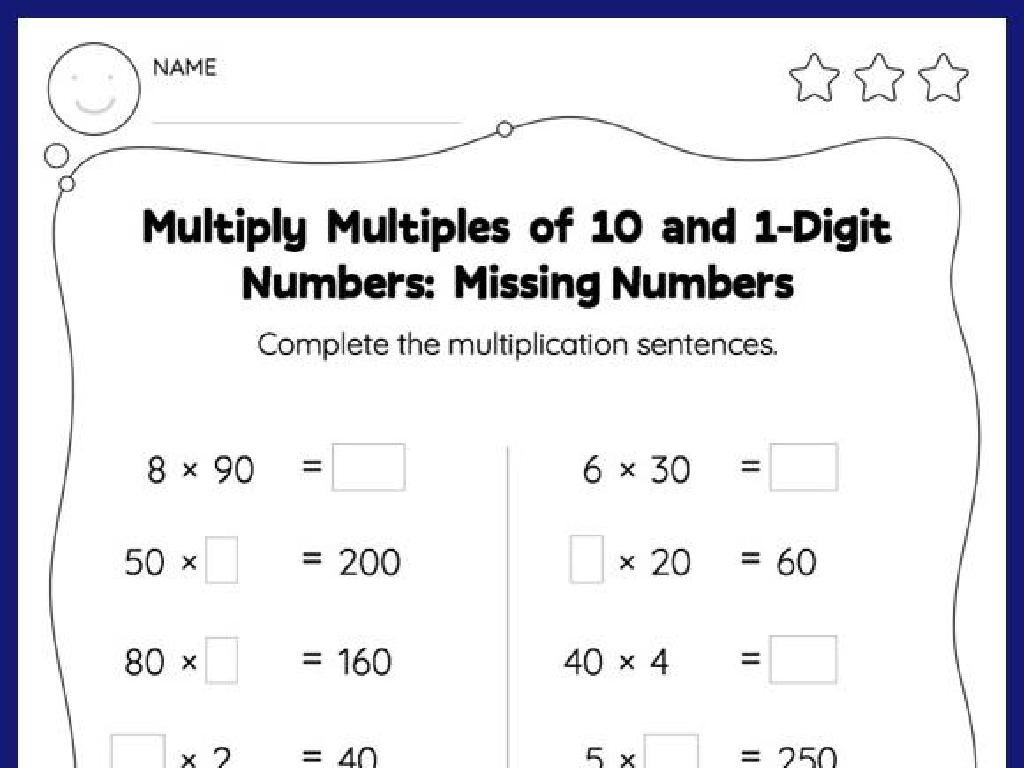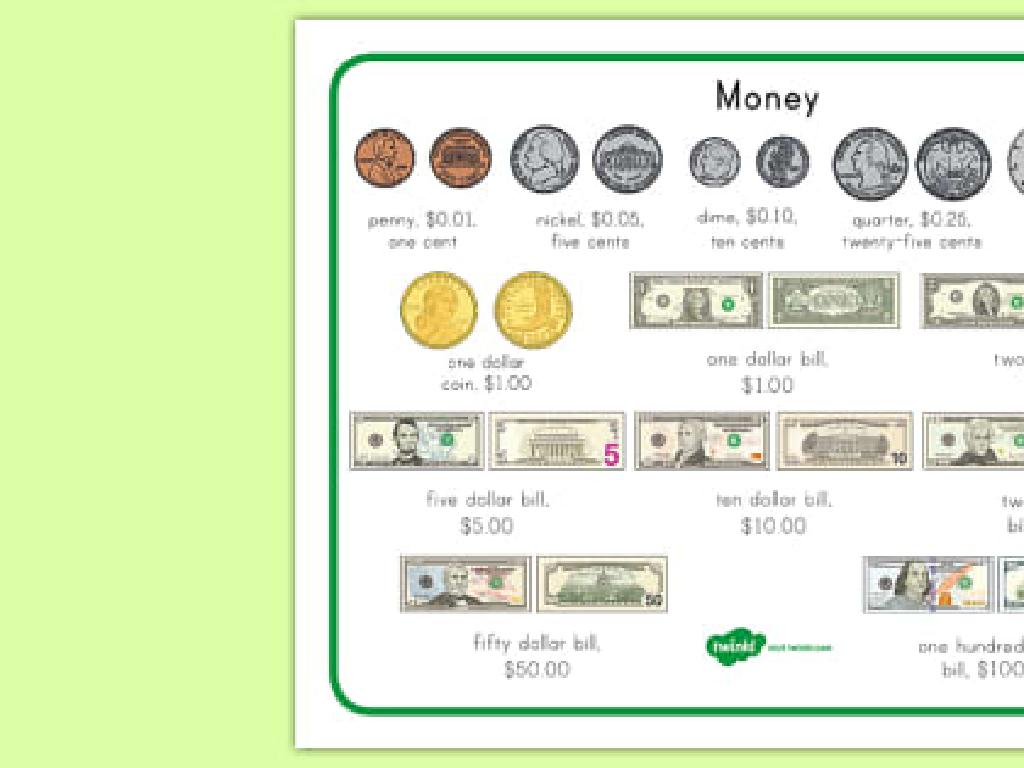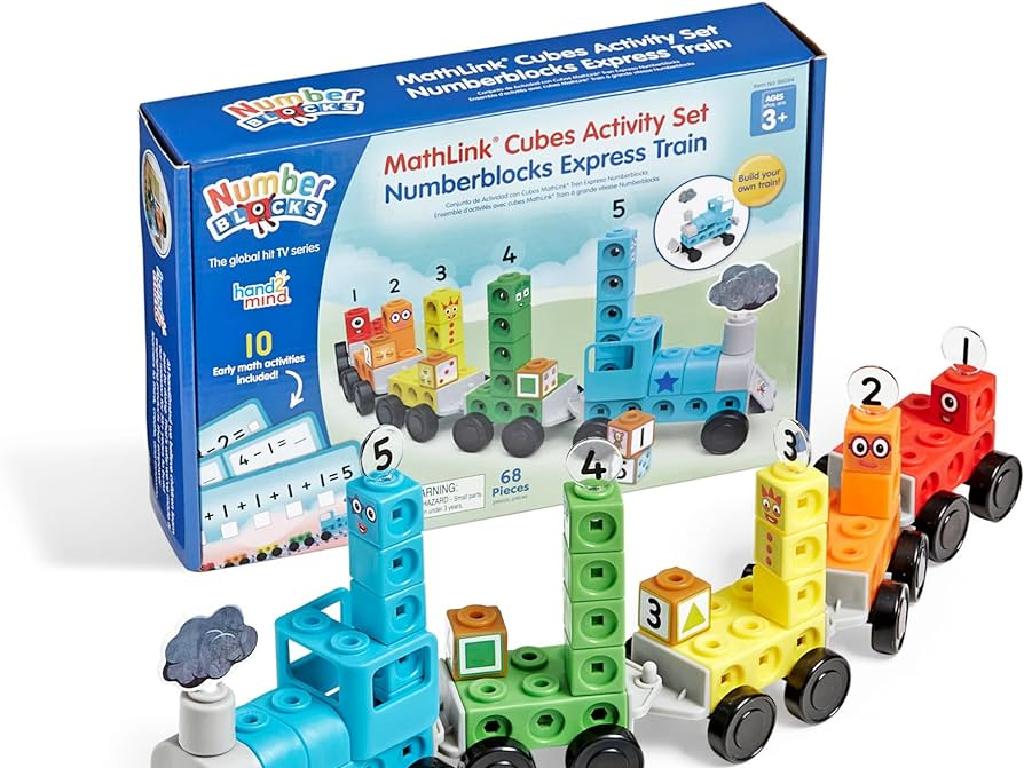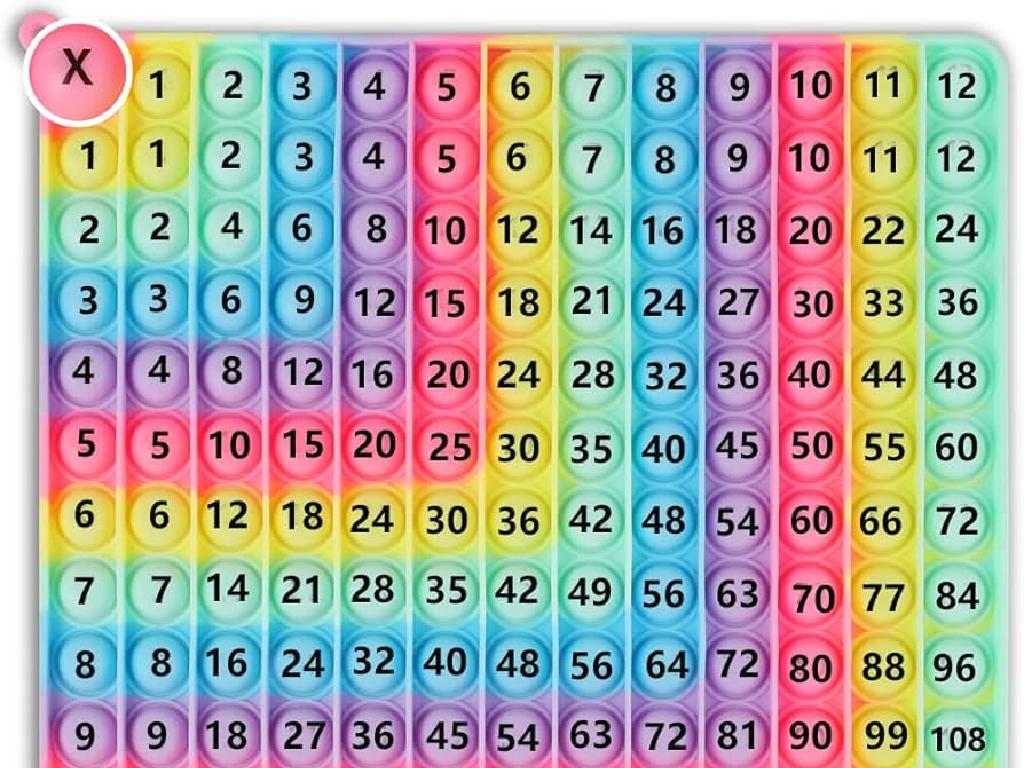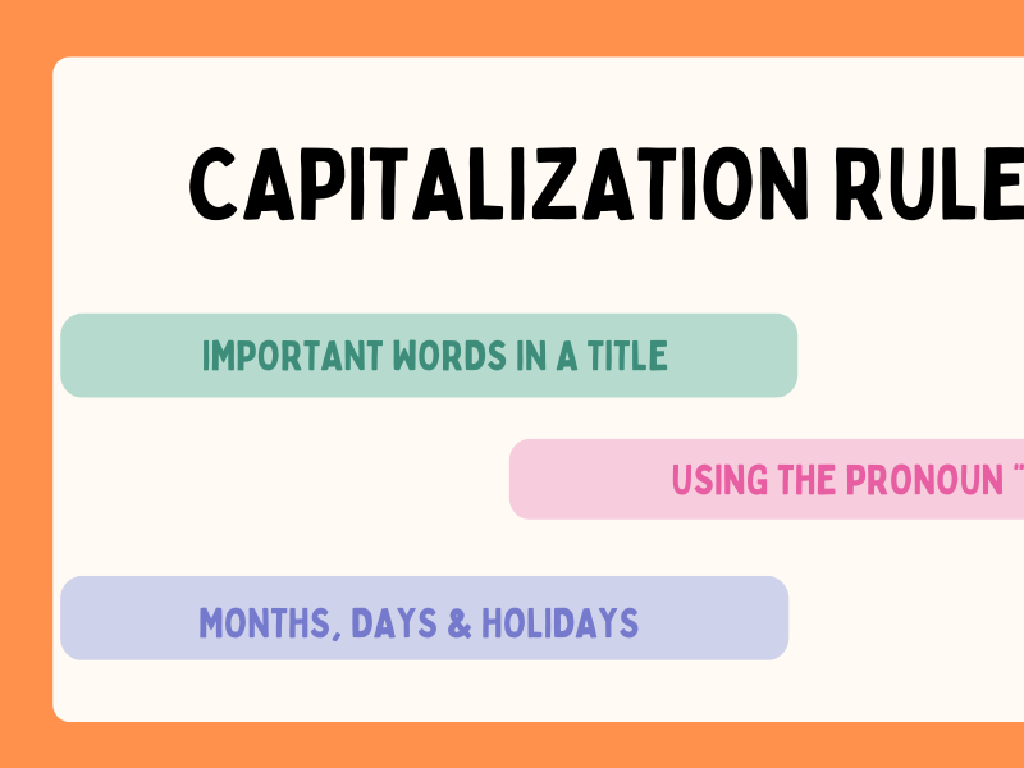Identify The Author'S Purpose: Passages
Subject: Language arts
Grade: Third grade
Topic: Theme
Please LOG IN to download the presentation. Access is available to registered users only.
View More Content
Understanding the Author’s Purpose
– Why do authors write stories?
– To entertain, inform, persuade, or share feelings
– Types of author’s purposes
– Persuade, Inform, Entertain, and Express feelings (PIEE)
– Examples of each purpose
– ‘The Very Hungry Caterpillar’ entertains, a science book informs
– Finding the purpose in stories we read
– Look for clues in the text about why the author wrote it
|
In today’s class, we’ll explore the reasons authors write stories. Understanding the author’s purpose helps us connect with the text and enhances comprehension. We’ll discuss the four main purposes: to persuade, to inform, to entertain, and to express feelings, often remembered by the acronym PIEE. We’ll look at examples of each, such as ‘The Very Hungry Caterpillar’ for entertainment and a science textbook for information. Encourage students to think about their favorite stories and what purpose they might serve. As an activity, students can choose a book and write down clues that help determine the author’s purpose.
Understanding the Author’s Purpose
– What is author’s purpose?
– It’s why an author writes a story or article.
– Three main purposes: PIE
– Persuade, Inform, Entertain – remember it as PIE!
– Multiple purposes possible
– Sometimes a story can both entertain and teach us.
– Examples in stories
– We’ll read a story and guess the author’s purpose!
|
This slide introduces the concept of the author’s purpose to third-grade students. Begin by explaining that every story or article is written with a specific reason in mind, which is the author’s purpose. Introduce the acronym PIE to help them remember the three main purposes: to Persuade, to Inform, and to Entertain. Clarify that authors can combine these purposes. For example, a story could be entertaining but also aim to teach a lesson. Use examples from familiar stories to illustrate each purpose. In the next class, plan an activity where students read a passage and determine the author’s purpose, reinforcing their understanding through practical application.
Understanding the Author’s Purpose: Persuasion
– What is persuasive writing?
– It’s writing that wants to make you agree with the author
– Persuasive writing aims to convince
– The author uses words to make you think or act differently
– Examples of persuasive texts
– Ads, speeches, and opinion pieces in newspapers
– Recognizing persuasive language
– Look for words that try to get you to do something or believe something
|
This slide introduces the concept of persuasive writing, which is one of the author’s purposes when creating a text. Persuasive writing is meant to influence the reader’s thoughts or actions. Provide examples like advertisements that try to get you to buy something, speeches that aim to sway your opinion, or opinion articles that present a strong stance on an issue. Teach students to identify persuasive language by looking for words that seem to push for a change in belief or action. Encourage them to think critically about what they read and to recognize when an author is trying to persuade them. This will help them become more discerning readers and understand the intent behind different types of texts.
Understanding the Author’s Purpose: To Inform
– What does ‘to inform’ mean?
– ‘To inform’ means the author wants to give us information.
– Informative writing shares facts
– It’s writing that teaches us real things without made-up stories.
– Examples: Textbooks and news
– Like when we read about history or what’s happening in the world.
– How-to guides explain tasks
– Step-by-step guides that help us learn how to do something new.
|
This slide introduces the concept of the author’s purpose to inform in writing. It’s crucial to explain to the students that when an author’s purpose is to inform, their main goal is to provide facts and information about a topic. Use examples that are relatable to third graders, such as their textbooks for history or science, articles about current events appropriate for their age, or how-to guides for crafts or simple tasks. Encourage the students to think about why the author chose to write these pieces and what they can learn from them. Discuss how informative texts are different from stories or persuasive writing. The goal is for students to recognize informative texts and understand their purpose.
Understanding the Author’s Purpose: To Entertain
– What does ‘to entertain’ mean?
– To entertain is to make reading enjoyable
– Entertaining writing amuses us
– Stories or texts that make us laugh or feel excited
– Examples: novels, comics, poems
– Harry Potter books, Garfield comics, Dr. Seuss’s poems
– Look for fun and imagination
|
This slide aims to help students recognize when an author’s purpose is to entertain. Explain that some writings are created just for enjoyment, to make us laugh, to take us on adventures, or to stir our imagination. Use familiar examples like popular children’s books, comic strips they might see in the newspaper, and fun poems. Encourage students to think about what makes these types of writing entertaining and to share their favorite stories or poems in class. Discuss how the language used in entertaining texts is often lively and imaginative. This will help them to identify and appreciate the author’s purpose in their future reading.
Understanding the Author’s Purpose
– Look for clues within the text
– Clues can be the setting, characters, or events.
– Consider words and phrases used
– Words like ‘firstly’ or ‘in conclusion’ hint at the author’s intent.
– Think about the overall message
– Is the story meant to entertain, inform, persuade, or teach?
– Ask: What’s the author’s goal?
– Is the author trying to make us laugh, give facts, or change our mind?
|
This slide aims to teach students how to determine an author’s purpose in writing. Encourage them to be detectives, looking for clues in the text such as specific words or phrases and the general theme of the passage. Discuss how the author’s choice of language can indicate whether they are trying to inform, entertain, persuade, or teach the reader. Provide examples of different texts that serve different purposes. In the next class, students can practice with passages, identifying the author’s purpose and supporting their answers with evidence from the text.
Let’s Practice Identifying the Author’s Purpose!
– Read a passage as a class
– Determine the author’s goal
– Is it to Persuade, Inform, or Entertain?
– Persuade: convince us of something, Inform: teach us new facts, Entertain: tell a fun story
– Discuss our thoughts together
|
This slide is for a class activity where students will practice identifying the author’s purpose in a given passage. Start by reading a passage together, ensuring that all students are engaged and following along. After reading, initiate a discussion with the class to determine the author’s purpose. Explain that authors typically write to persuade, inform, or entertain their readers. Provide examples of each purpose to help students differentiate between them. For instance, a commercial might be trying to persuade, a textbook might inform, and a fairy tale might entertain. Encourage students to use clues from the text and their own reasoning to decide the purpose of the passage they read. Conclude the activity with a group discussion where students can share their thoughts and reasoning.
Class Activity: Author’s Purpose Hunt
– Find passages in group books
– Determine the author’s purpose
– Is it to inform, entertain, persuade, or explain?
– Share findings with the class
– Discuss reasons behind the writing
– Think about what the author wants you to feel or do
|
This activity is designed to help students work collaboratively to understand the concept of author’s purpose in literature. Break the class into small groups and provide a selection of books suitable for third graders. Each group should find passages and discuss among themselves to identify the author’s purpose: to inform, entertain, persuade, or explain. Afterward, they will share their findings with the class and discuss their reasoning. This will help students to not only recognize the author’s intent but also to articulate their thoughts and engage in critical thinking. As a teacher, facilitate the discussion by asking probing questions and providing guidance to ensure each group understands the concept. Possible activities for different groups could include finding examples of different purposes, creating posters of their findings, or even acting out the intent of the passages they choose.
Mastering Author’s Purpose
– Review writing purposes
– Remember: to inform, persuade, entertain
– Why author’s purpose matters
– Knowing the purpose improves reading skills
– Practice makes perfect
– Becoming a purpose-spotting pro
– Keep practicing with different texts
|
As we wrap up, let’s revisit the three main reasons why authors write: to inform, persuade, and entertain. Understanding the author’s purpose is crucial because it helps us to become better readers who can critically analyze and enjoy texts. Encourage the students to keep practicing by reading various passages and identifying the author’s intent. With consistent practice, they will become adept at quickly spotting the author’s purpose, enhancing their comprehension and appreciation of literature.

